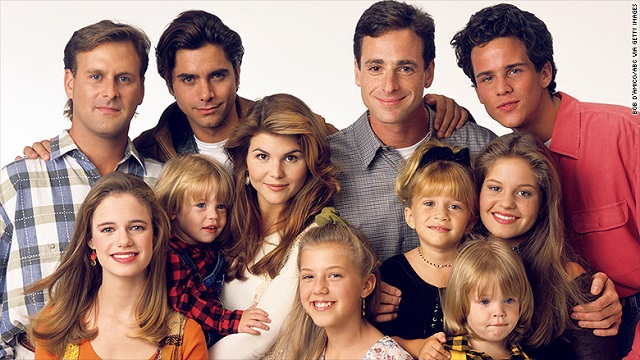Admit it. A little part of your soul died when you heard Netflix greenlit a 13-episode revival of Full House. Sure, it was all fun, flannel, and Doc Martens when Showtime announced they were bringing back Twin Peaks and Fox agreed to re-open The X-Files. But then Coach got inexplicably thrown back in the game, and Full House was resuscitated as Fuller House, and suddenly you were side-eyeing your television, afraid it was about to morph from a sleek wide-screen into a clunky 1990s CRT.
But don’t despair. Fuller House isn’t a sign TV’s current “golden age” has ended; it’s actually a sign that it’s still thriving. There is such a surplus of good, original television content available from so many sources that it’s nearly impossible for productions to get noticed. It’s understandable that networks are tempted by known commodities that can generate instant buzz. Like reboots and spin-offs, revivals cut through the clutter and provide massive free publicity before anyone spends a dime on advertising. People who are excited by a revival tweet about it. People who are horrified also tweet about it. And then begins the speculation regarding which cast members and writers will be involved. You want Dave Coulier trending on Twitter? You got it, dude.
Overall, revivals are considerably less terrifying—and more entertaining to watch unfold—than reboots. Yes, the reimagining of Battlestar Galactica was awesome, but the remakes of Bionic Woman, Knight Rider, and Ironside were decidedly less so. Unlike a reboot, which is a proven property propped up by a new creator and cast who rarely compare favorably to the originals, a revival is an attempt to get the old band back together. Just like with reunion tours, creative will, availability, and egos must be carefully managed. Sometimes all the stars literally align, like with The X-Files, and you end up with 2015 Fleetwood Mac. Sometimes, as in the case of Twin Peaks, things take a confusing behind-the-scenes turn, and you end up with something closer to 2014 Led Zeppelin.
But whatever the ultimate percentage of original participants a revival has, its point is to rejoin a story, rather than reinvent it, and to revisit favorite characters, instead of recasting them. Revivals are blatant nostalgia grabs, yes, but they also recognize that a show’s success is not just based on a concept, but on its execution by a particular creative team. That equation, of course, doesn’t take into account the role that a specific moment in time may have played in a show’s success, but that just adds to the peripheral drama surrounding a revival. Can Chris Carter, David Duchovny, and Gillian Anderson recapture what they once had? That’s a subplot plenty of fans will invest in.
The current revival phenomenon is made possible, in part, due to the growing popularity of shortened seasons and limited runs, which have long been the standard in the U.K. and have been more recently embraced by U.S. cable networks. These mini-series of six to 13 episodes hit a storytelling sweet spot, providing more character depth and scope than a film, but less fat than a standard 22-episode series. They also make it easier to attract talent that might not commit to a full series. Duchovny told USA Today he never would have agreed to a 22-episode season of The X-Files. “We’re all old,” he explained. “We don’t have the energy for a full season.”
Limited run series are also appealing to showrunners and writers. Not only do they get the chance to revisit their characters with fresh insight after years away, but the short orders allow them to focus on tighter storylines with specific endpoints. This means there will be no unresolved cliffhangers or meandering episodes written just to meet a full season order. Some of the revivals will fail, and some will be renewed, but regardless of the outcome, fans will be given some sort of closure.
Which brings us to the other force behind the revival trend: Netflix. The subscription service and its competitors Amazon, Hulu, and Yahoo have upended the traditional syndication market. Future viewing potential is now more important than the number of episodes produced. If fans are going to bother binge-watching a series, they want a satisfying conclusion when they hit the last episode.
This means low-rated shows that would have been canceled a few years ago are sometimes allowed to come to a conclusion on their own network, or are outright saved by a streaming service. The Killing, Ripper Street, Community, and possibly The Mindy Project have all been given reprieves this way.
Because of the Netflix model, revivals ultimately feed the growth of original programming. When 20th Century Fox resurrected 24 for the 12-episode stand-alone series 24: Live Another Day in 2014, they also inked an exclusive deal with Amazon for the show’s previous eight seasons. As Forbes points out, Fox is likely aiming to repeat that exclusivity trick with The X-Files. Fans can currently stream all 202 original episodes on Netflix before its revival airs in 2016. The six-episode X-Files coda will make a new deal very attractive for both parties. This helps Fox keep low-rated but highly praised shows like FX’s The Americans on the air, and helps Netflix and Amazon Studios fund their own original programming or save another network’s floundering gem.
Old Full House episodes are not yet available for streaming, but Fuller House means they certainly will be in the near future. And all the people who binge-watch to indulge their nostalgic feels for Uncle Jesse’s mullet will unwittingly do their part to save better shows everywhere.
— A.R. Wilson



